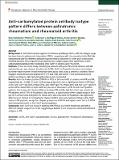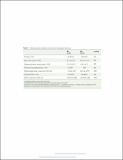Por favor, use este identificador para citar o enlazar a este item:
http://hdl.handle.net/10261/226112COMPARTIR / EXPORTAR:
 SHARE SHARE
 CORE
BASE CORE
BASE
|
|
| Visualizar otros formatos: MARC | Dublin Core | RDF | ORE | MODS | METS | DIDL | DATACITE | |

| Título: | Anti-carbamylated protein antibody isotype pattern differs between palindromic rheumatism and rheumatoid arthritis |
Autor: | Castellanos-Moreira, Raul; Rodriguez-García, Sebastian C.; Cabrero-Villalba, Sonia; Gómara Elena, María José CSIC ORCID; Salvador, Georgina; Ruiz-Esquide, Virginia; Ramírez, Julio; Inciarte-Mundo, José; Morlà, Rosa; García-Moreno, Cristina CSIC ORCID; Cuervo, Andrea; Gómez-Puerta, José A.; Cañete, Juan D.; Haro Villar, Isabel CSIC ORCID ; Sanmartí, Raimon | Palabras clave: | ACPA Anti-CarP B cells Autoantibodies Palindromic rheumatism Rheumatoid arthritis |
Fecha de publicación: | 10-dic-2020 | Editor: | Sage Publications | Citación: | Therapeutic Advances in Musculoskeletal Disease 12: 1-10 (2020) | Resumen: | [Background]: A restricted response against citrullinated peptides/proteins, with less isotype usage, has been found in palindromic rheumatism (PR) in comparison with rheumatoid arthritis (RA). We hypothesized that this different antibody response may be observed for other post-translational modified proteins. We compared the prevalence and isotype usage of two specificities of anti-carbamylated peptide/protein antibodies (Anti-CarP) in patients with PR and RA. [Methods]: Cross-sectional study including 54 patients with pure PR and 53 patients with RA, matched by sex, age, disease duration and ACPA. Anti-CarP specificities were determined by home-made enzyme-linked immunosorbent assay tests using a synthetic chimeric fibrin/filaggrin homocitrullinated peptide (CFFHP) and fetal calf serum (FCS) homocitrullinated protein as antigens. IgG, IgA and IgM isotypes were measured. [Results]: Anti-CarP were positive (CFFHP or FCS) in 24% and 64% of patients with PR and RA, respectively (p < 0.005). All Anti-CarP isotype proportions were significantly lower in PR than in RA: Anti-CarP-IgG (24% versus 51%), Anti-CarP-IgA (7% versus 34%) and Anti-CarP-IgM (7% versus 36%). Mean titers of Anti-CarP isotypes were also lower in PR. In Anti-CarP positive patients, the isotype distribution differed between PR and RA: IgG Anti-CarP was used in all PR patients and in 79% of RA patients. By contrast, a significantly lower isotype usage of both IgA (31% versus 53%) and IgM (31% versus 56%) was observed in PR patients. No significant differences in clinical or demographic characteristics were observed according to Anti-CarP status in PR patients, except for a higher prevalence of ACPA and higher mean titers of ACPA and rheumatoid factor in Anti-CarP positive patients. [Conclusion]: Anti-CarP are found in patients with PR but in a lower proportion and with a different isotype usage from in RA, suggesting a distinct B cell response to homocitrullinated antigens in PR. |
Versión del editor: | https://doi.org/10.1177/1759720X20978139 | URI: | http://hdl.handle.net/10261/226112 | DOI: | 10.1177/1759720X20978139 | E-ISSN: | 1759-7218 |
| Aparece en las colecciones: | (IQAC) Artículos |
Ficheros en este ítem:
| Fichero | Descripción | Tamaño | Formato | |
|---|---|---|---|---|
| 1759720x20978139.pdf | Artículo principal | 752,44 kB | Adobe PDF |  Visualizar/Abrir |
| 10.1177-1759720X20978139-table1-1759720X20978139.pdf | Material suplementario | 284,85 kB | Adobe PDF |  Visualizar/Abrir |
CORE Recommender
PubMed Central
Citations
2
checked on 22-abr-2024
SCOPUSTM
Citations
8
checked on 23-abr-2024
WEB OF SCIENCETM
Citations
6
checked on 25-feb-2024
Page view(s)
117
checked on 24-abr-2024
Download(s)
156
checked on 24-abr-2024

